Related Research Articles

Imhotep was an Egyptian chancellor to the Pharaoh Djoser, possible architect of Djoser's step pyramid, and high priest of the sun god Ra at Heliopolis. Very little is known of Imhotep as a historical figure, but in the 3,000 years following his death, he was gradually glorified and deified.
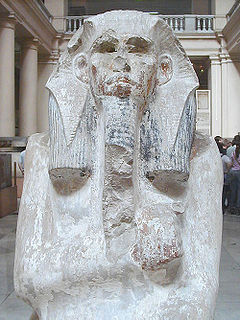
Djoser was an ancient Egyptian pharaoh of the 3rd Dynasty during the Old Kingdom, and was the founder of that epoch. He is also known by his Hellenized names Tosorthros and Sesorthos. He was the son of king Khasekhemwy and queen Nimaathap, but whether he was also the direct successor to their throne is unclear. Most Ramesside king lists identify a king named Nebka as preceding him, but there are difficulties in connecting that name with contemporary Horus names, so some Egyptologists question the received throne sequence. Djoser is known for his step pyramid, which is the earliest colossal stone building in ancient Egypt.

Nefertari, also known as Nefertari Meritmut, was an Egyptian queen and the first of the Great Royal Wives of Ramesses the Great. Nefertari means 'beautiful companion' and Meritmut means 'Beloved of the goddess Mut'. She is one of the best known Egyptian queens, among such women as Cleopatra, Nefertiti, and Hatshepsut, and one of the most prominent not known or thought to have reigned in her own right. She was highly educated and able to both read and write hieroglyphs, a very rare skill at the time. She used these skills in her diplomatic work, corresponding with other prominent royals of the time. Her lavishly decorated tomb, QV66, is one of the largest and most spectacular in the Valley of the Queens. Ramesses also constructed a temple for her at Abu Simbel next to his colossal monument there.
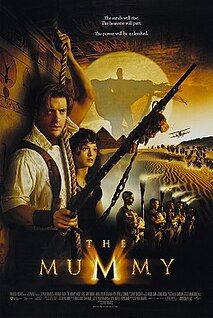
The Mummy is a 1999 American fantasy action-adventure film written and directed by Stephen Sommers. It is a remake of the 1932 film of the same name, starring Brendan Fraser, Rachel Weisz, John Hannah, Kevin J. O'Connor, and Arnold Vosloo in the title role as the reanimated mummy. The film follows adventurer Rick O'Connell as he travels to Hamunaptra, the City of the Dead, with a librarian and her older brother, where they accidentally awaken Imhotep, a cursed high priest with supernatural powers.

The Mummy is a 1932 American pre-Code supernatural horror film directed by Karl Freund. The screenplay by John L. Balderston was adapted from a treatise written by Nina Wilcox Putnam and Richard Schayer. Released by Universal Studios as a part of the Universal Classic Monsters franchise, the film stars Boris Karloff, Zita Johann, David Manners, Edward Van Sloan and Arthur Byron.

The tomb of Tutankhamun, also known by its tomb number, KV62, is the burial place of Tutankhamun, a pharaoh of the Eighteenth Dynasty of ancient Egypt, in the Valley of the Kings. The tomb consists of four chambers and an entrance staircase and corridor. It is smaller and less extensively decorated than other Egyptian royal tombs of its time, and it probably originated as a tomb for a non-royal individual that was adapted for Tutankhamun's use after his premature death. Like other pharaohs, Tutankhamun was buried with a wide variety of funerary objects and personal possessions, such as coffins, furniture, clothing and jewellery, though in the unusually limited space these goods had to be densely packed. Robbers entered the tomb twice in the years immediately following the burial, but Tutankhamun's mummy and most of the burial goods remained intact. The tomb's low position, dug into the floor of the valley, allowed its entrance to be hidden by debris deposited by flooding and tomb construction. Thus, unlike other tombs in the valley, it was not stripped of its valuables during the Third Intermediate Period.

The Valley of the Queens is a site in Egypt, where the wives of pharaohs were buried in ancient times. It was known then as Ta-Set-Neferu, meaning "the place of beauty". It was most famous for being the burial site of many wives of Pharaohs. Pharaohs themselves were buried in the Valley of the Kings.

Sitre or Tia-Sitre, was the Great Royal Wife of Pharaoh Ramesses I of Egypt and mother of Seti I.
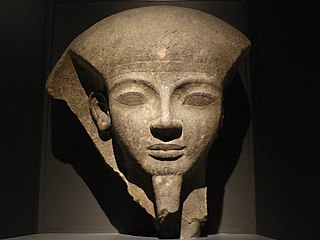
Ramesses VI Nebmaatre-Meryamun was the fifth ruler of the Twentieth Dynasty of Egypt. He reigned for about eight years in the mid-to-late 12th century BC and was a son of Ramesses III and queen Iset Ta-Hemdjert. As a prince, he was known as Ramesses Amunherkhepeshef and held the titles of royal scribe and cavalry general. He was succeeded by his son, Ramesses VII Itamun, whom he had fathered with queen Nubkhesbed.

QV66 is the tomb of Nefertari, the Great Wife of Pharaoh Ramesses II, in Egypt's Valley of the Queens. It was discovered by Ernesto Schiaparelli in 1904. It is called the Sistine Chapel of Ancient Egypt. Nefertari, which means "beautiful companion", was Ramesses II's favorite wife; he went out of his way to make this obvious, referring to her as "the one for whom the sun shines" in his writings, built the Temple of Hathor to idolize her as a deity, and commissioned portraiture wall paintings. In the Valley of the Queens, Nefertari's tomb once held the mummified body and representative symbolisms of her, like what most Egyptian tombs consisted of. Now, everything had been looted except for two thirds of the 5,200 square feet of wall paintings. For what still remains, these wall paintings characterized Nefertari's character. Her face was given a lot of attention to emphasize her beauty, especially the shape of her eyes, the blush of her cheeks, and her eyebrows. Some paintings were full of lines and color of red, blue, yellow, and green that portrayed exquisite directions to navigating through the afterlife to paradise.
Tomb KV45 is an ancient Egyptian tomb located in the Valley of the Kings in Egypt. It was originally used for the burial of the noble Userhet of the Eighteenth Dynasty and was reused by Merenkhons and an unknown woman in the Twenty-second Dynasty. The tomb was discovered and excavated by Howard Carter in 1902, in his role as Chief Inspector of Antiquities, on behalf of Theodore M. Davis. The tomb was later re-investigated by Donald P. Ryan of the Pacific Lutheran University Valley of the Kings Project in 1991 and 2005.
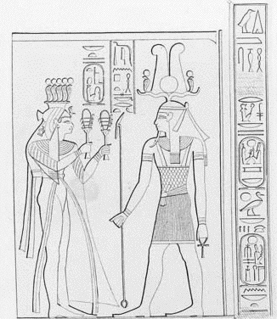
Iset Ta-Hemdjert or Isis Ta-Hemdjert, simply called Isis in her tomb, was an ancient Egyptian queen of the Twentieth Dynasty; the Great Royal Wife of Ramesses III and the Royal Mother of Ramesses VI.

Henuttawy was an ancient Egyptian princess of the 19th Dynasty.
Tyti was an ancient Egyptian queen of the 20th Dynasty. A wife and sister of Ramesses III and possibly the mother of Ramesses IV.

The Zamani Project is part of the African Cultural Heritage Sites and Landscapes Database. Zamani is a research group at the University of Cape Town, which acquires, models, presents and manages spatial and other data from cultural heritage sites. The present focus of the Zamani project is Africa, with the principal objective of developing “The African Cultural Heritage Sites and Landscapes Database”. Zamani comes from the Swahili phrase “Hapo zamani za kale” which means “Once upon a time”, and can be used to mean 'the past'. The word is derived from Arabic root for temporal vocabulary, ‘Zaman,’ and appears in several languages around the world.

The Ministry of Tourism & Antiquities is the Egyptian government organization which serves to protect and preserve the heritage and ancient history of Egypt. In December 2019 it was merged into the Ministry of Tourism with Khaled al-Anani retaining his function.
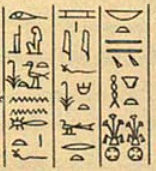
QV75 is the tomb of Henutmire, likely the daughter and Great Wife of Ramesses II, in Egypt's Valley of the Queens. It was mentioned by Champollion and Lepsius.

QV80 is the tomb of (Mut-)Tuya, the Great Royal Wife of Seti I, and the mother of Ramses II, in Egypt's Valley of the Queens.
Tanejemet of Tanedjemy is a King's daughter and King's Wife from the New Kingdom. She is possibly a daughter of Ramesses I and wife of Seti I.
References
- 1 2 3 4 Demas, Martha, and Neville Agnew, eds. 2012. Valley of the Queens Assessment Report: Volume 1. Los Angeles, CA: Getty Conservation Institute. Getty Conservation Institute, link to article
- ↑ Porter, Bertha and Moss, Rosalind, Topographical Bibliography of Ancient Egyptian Hieroglyphic Texts, Statues, Reliefs and Paintings Volume I: The Theban Necropolis, Part 2. Royal Tombs and Smaller Cemeteries, Griffith Institute. 1964, pg 766-7